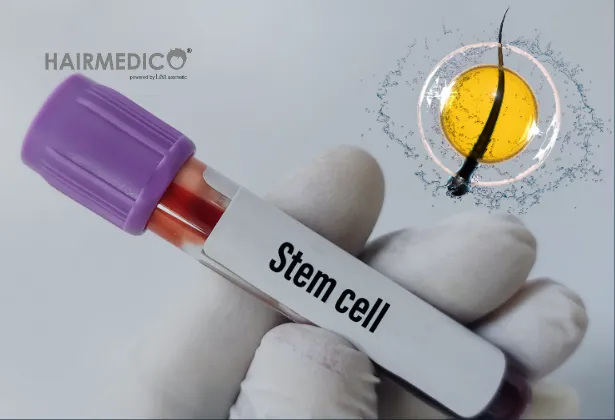
Discover how stem cell technology is transforming hair restoration in 2025. Learn the science, benefits, procedure, costs in €, legal status, and future potential of stem cell hair transplants in Turkey — with expert insights from Hairmedico.
In 2025, stem cell hair transplantation is redefining what is possible in hair restoration. Patients in Turkey are now turning to regenerative medicine options that go beyond traditional FUE or DHI techniques.
At Hairmedico, led by Dr. Arslan Musbeh, stem cell-based therapies are integrated with AI-driven hair transplant planning to improve graft survival, stimulate regeneration, and preserve the donor area for future procedures.
A stem cell hair transplant is a regenerative medicine approach that uses the patient’s own stem cells to stimulate new hair growth and repair damaged follicles.
Unlike traditional hair transplants — which relocate follicles from one area to another — stem cell therapy focuses on rejuvenating existing follicles and potentially creating new ones.
Stem cells are undifferentiated cells capable of transforming into various cell types. In the scalp, follicular stem cells regulate the natural hair growth cycle.
Hair loss often results from the dormancy or depletion of these cells, caused by genetics, hormonal changes, or tissue damage.
Mesenchymal stem cells, often derived from adipose (fat) tissue, are rich in growth factors that can activate dormant follicles and promote tissue regeneration.
While both PRP and stem cell therapy aim to stimulate hair growth, their mechanisms are different:
PRP: Concentrates platelets from the patient’s blood to release growth factors.
Stem Cells: Provide regenerative cells capable of repairing tissues and potentially forming new follicle structures.
👉 Stem cell therapy offers a more advanced regenerative potential than PRP.
Stem cell therapy can enhance outcomes when combined with traditional methods:
FUE Hair Transplant: Stem cells improve graft survival and donor healing.
DHI Hair Transplant: Direct implantation with stem cells accelerates regrowth.
Unshaven Hair Transplant: Enables discreet recovery while benefiting from regenerative support.
Early to moderate hair loss.
Low donor density.
Scarring alopecia.
Patients seeking to maximize results from traditional transplants.
Consultation & AI Analysis
Stem Cell Harvesting
Laboratory Processing
Recipient Area Preparation
Injection / Implantation
Post-Procedure Aftercare
Higher graft survival rates.
Faster healing and recovery.
Potential follicle regeneration.
Less trauma in the donor area.
Stem cell therapy is still under active research. Results vary, and fully bald areas may require a traditional hair transplant. Multiple sessions may be necessary.
Turkey: €2,500 – €5,000 (often includes hotel and transfers).
Europe: €6,000 – €10,000.
United States: €12,000 and above.
In Turkey, regenerative medical treatments — including stem cell therapy — must comply with Ministry of Health regulations.
Clinics must hold the proper licenses and certifications.
Hairmedico operates within this framework, ensuring safe, ethical, and legally compliant procedures.
Case 1: 32-year-old male with low donor density benefits from FUE + stem cell combination.
Case 2: 45-year-old female with scarring alopecia experiences visible density increase.
Case 3: 28-year-old male chooses unshaven hair transplant with stem cell support for discreet recovery.
Gentle hair washing.
Avoid direct sun exposure.
Maintain a balanced diet.
Attend follow-up visits.
Additional PRP or LLLT (Low-Level Laser Therapy) sessions may be recommended for optimal results.
Over the next decade, hair cloning combined with AI-guided implantation could revolutionize hair restoration.
Stem cell therapy is a key stepping stone toward that future.
Q1: Is it painful?
A: Minimal discomfort under local anesthesia.
Q2: How soon will I see results?
A: Visible results usually appear within 3–6 months.
Q3: Can it replace a transplant?
A: Yes, in early-stage hair loss. For advanced cases, it’s best combined with FUE/DHI.
Q4: Is it legal in Turkey?
A: Yes, under the Ministry of Health regulations.